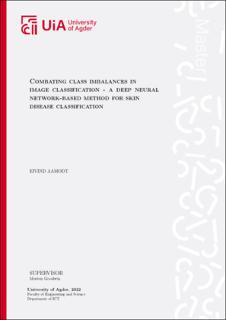| dc.description.abstract | Skin cancer is the most common type of cancer globally, and the current estimates say that as many as one in five Americans will develop one form of skin cancer in their lifetime. While there are many types of skin cancer, some of the more severe types can lead to life expectancies of less than five years if the cancer is left untreated. While these statistics are very severe, early detection and treatment are very prominent, reaching survival rates as high as 99\% in cases where the cancer was spotted and removed early on. Unfortunately, traditional methods of diagnosis are very time-consuming and not always accurate, causing skin cancer to be one of the cancer types with the highest misdiagnosis rate.
Due to early diagnosis and treatment having such a critical role in patients' survival rate and life expectancy, together with the time-consuming and high error rate of classical diagnosis methods, a better method of diagnosing skin cancer is needed. Deep learning and convolutional neural networks have shown very promising results in image analysis in the past few years due to the ability to extract multiple features out of an image that are not recognizable to humans. Tasks that predominantly contain visual symptoms, such as skin lesions in this case, are perfect use cases where convolutional neural networks shine.
In this thesis, I have taken a deep dive into how convolutional neural networks can be used on dermoscopic images of skin cancer. To see how they performed, multiple state-of-the-art CNN models were tested, such as ResNet34, VGG16, and EfficientNet\_B4. Experimentation with methods such as utilizing different types of image augmentation, oversampling, class grouping, different train/valid/test splits, and using multiple models that vote and act as a jury were conducted to combat the severe class imbalances in the dataset. The best models achieved a classification accuracy of 84.62\% between the seven classes and 85.81\% classification accuracy when working as an anomaly detector.
In cases where a hospital wants to reduce the workload by making the model perform all of the easy classifications, a model using confidence thresholds was made. The threshold can be changed based on the accuracy requirements of the hospital. For example, If a 90\% accuracy is required, the model will achieve it while diagnosing 90\% of the patients. If a 95\% accuracy is required, it will achieve the results by diagnosing 70\% of the patients. In cases where the network is not allowed to make any mistakes, the model managed 99.5\% accuracy while still diagnosing 40\% of the patients, almost cutting the hospital's workload in half.
All of my models outperformed human experts (60-76\%) by a large margin. Because there is such a significant increase in performance, utilizing these new artificial intelligence models in the real world can save countless lives. | |
